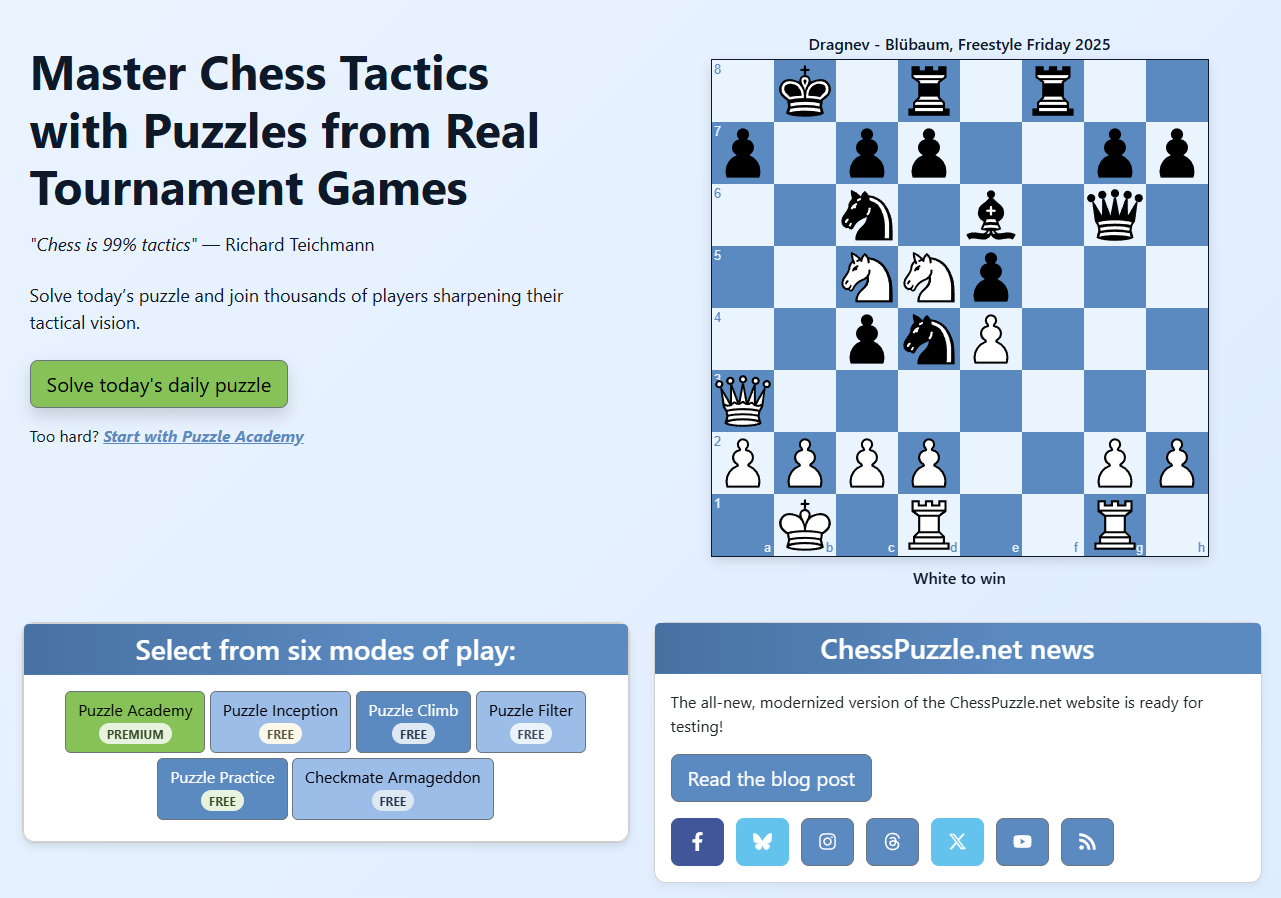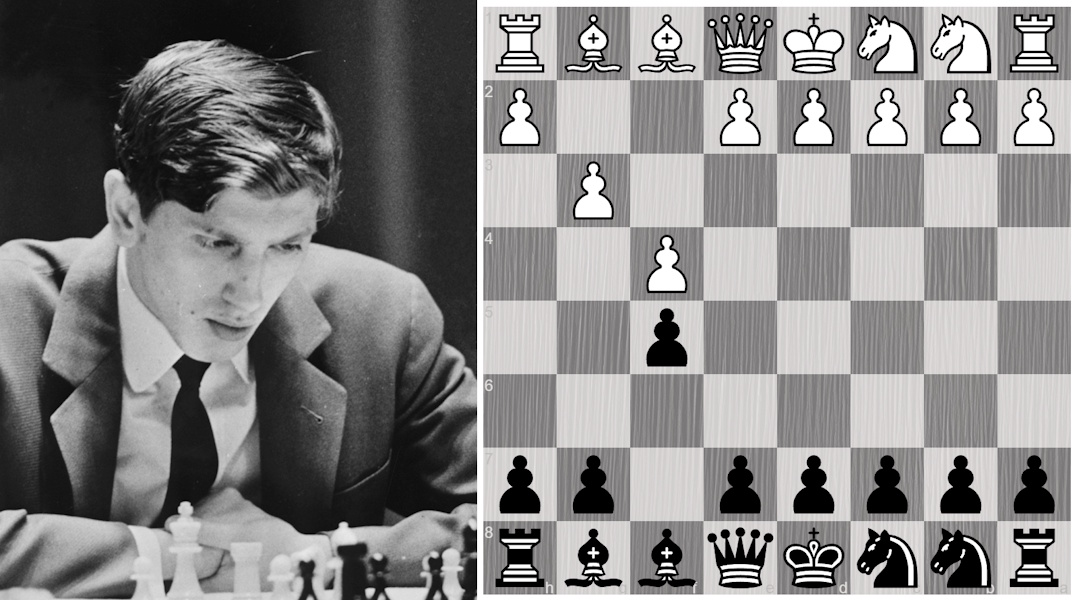Intermediate Chess Puzzles out, many updates to ChessPuzzle.net and Puzzle Academy!
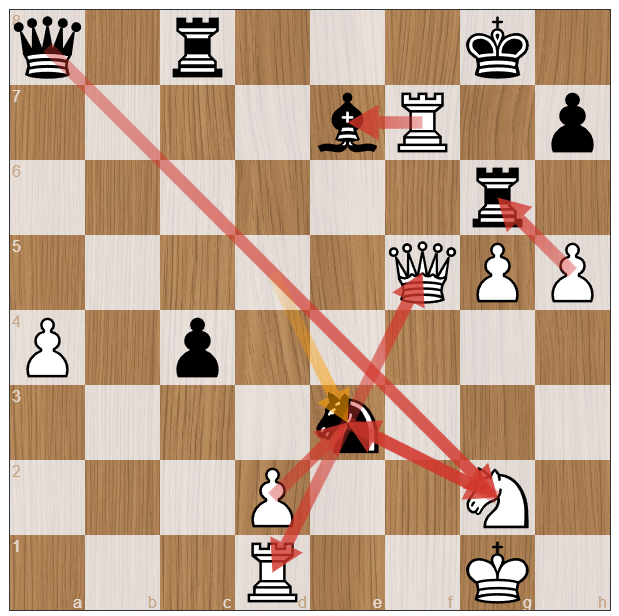
Welcome to the latest update on ChessPuzzle.net! This month, I'm excited to share new features, updates, and content that will elevate your chess-solving experience. Whether you're a beginner or an experienced player, there's something here for everyone to enjoy.
Intermediate Chess Puzzles is out
My second book "Intermediate Chess Puzzles" is out now in the US, and will be available in the UK and other countries soon. The first book "Beginner Chess Puzzles" is also available in many countries now. You can find more information about the books, and how to order them, on the landing page.
Improvements to Puzzle solving: Refutation moves
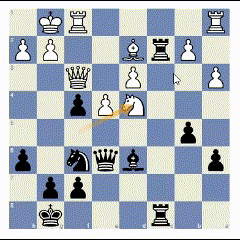
For many puzzles generated with version 3 of the puzzle algorithm, you will now see a refutation move played on the board immediately, when you make a mistake when solving a puzzle.
In many cases, this can explain immediately why your move was a mistake. For further analysis, the refutation move is also shown in the solution view.
Here is an example: Black captures the bishop, and then the refutation move capturing the queen is shown:
Prevent screen dimming or locking on mobile devices
When you solve a puzzle on a supported mobile device, the screen will no longer dim or lock while you are solving the puzzle. This is especially useful in a difficult puzzle where you need to think for a longer time. Note that this is not supported on all devices, and may be disabled by your device settings, or when in energy saving mode.
Updates to the Solution View
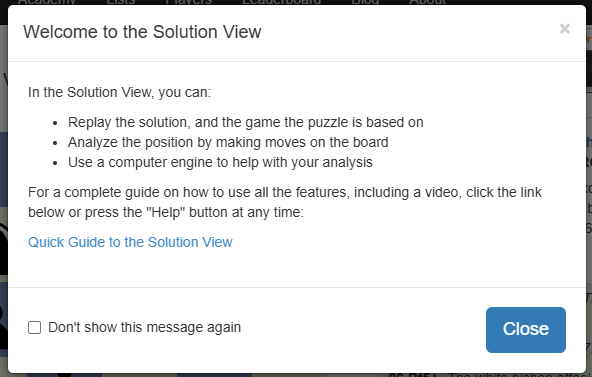
Users are sometimes unaware that you can analyze your own moves in the solution view, and can get help from an engine, to better understand the puzzle and its solution. I've added an introduction message to the solution view to make this more clear. You can click the checkbox to hide this message in the future.
I've also updated the guide to the solution view with a description of the newest features. You can always access the guide by clicking the "Help" button in the solution view.

In defence puzzles, and in garbage collection puzzles, the threats are now visualized with red arrows in the solution view. The image shows a particularly confusing garbage collection puzzle.
Grouped Lists
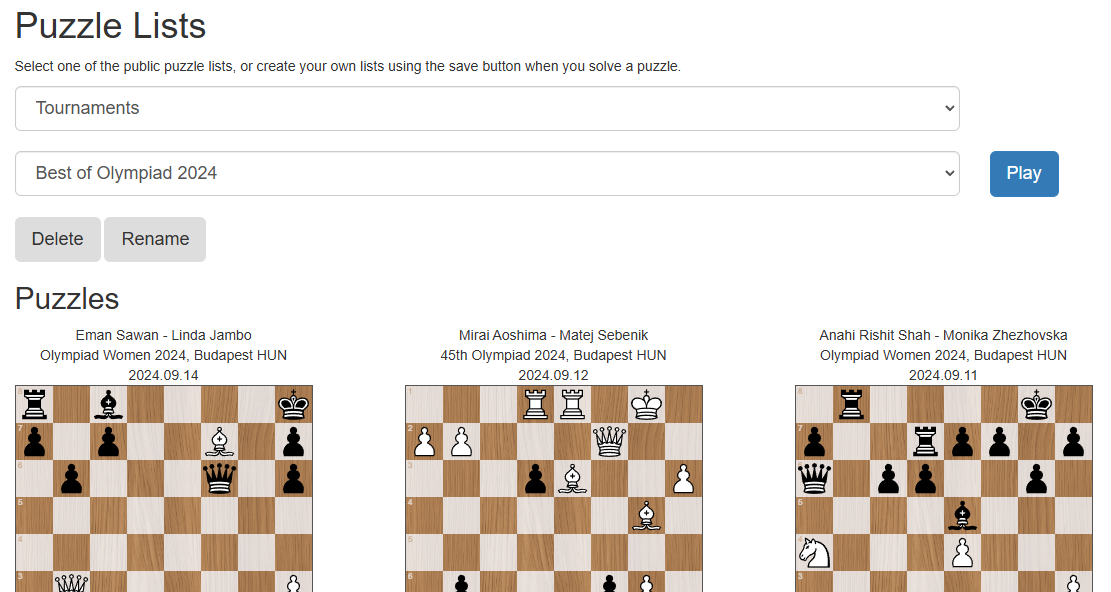
The lists feature has been updated. The lists are now divided into five different groups:
- Best Puzzles: This group contains lists with the Daily Puzzles, the best checkmate puzzles, the best puzzles of the year, puzzles featured by Chess On, and the weekly puzzle with a video by Daniel King.
- Your Lists: This group includes the list of the puzzles you played, liked, failed and solved, as well as all the lists you created by using the save feature.
- Tournaments: Lists with the best puzzles selected for various tournaments, for example the Chess Olympiad 2024.
- English Chess Federation: Every month I select puzzles from English tournaments and English players for the newsletter of the English Chess Federation.
- Automatic Lists: These lists are updated automatically, and include puzzles from recently played games, and the most popular puzzles based on the number of likes by our users.
Puzzle Academy updates
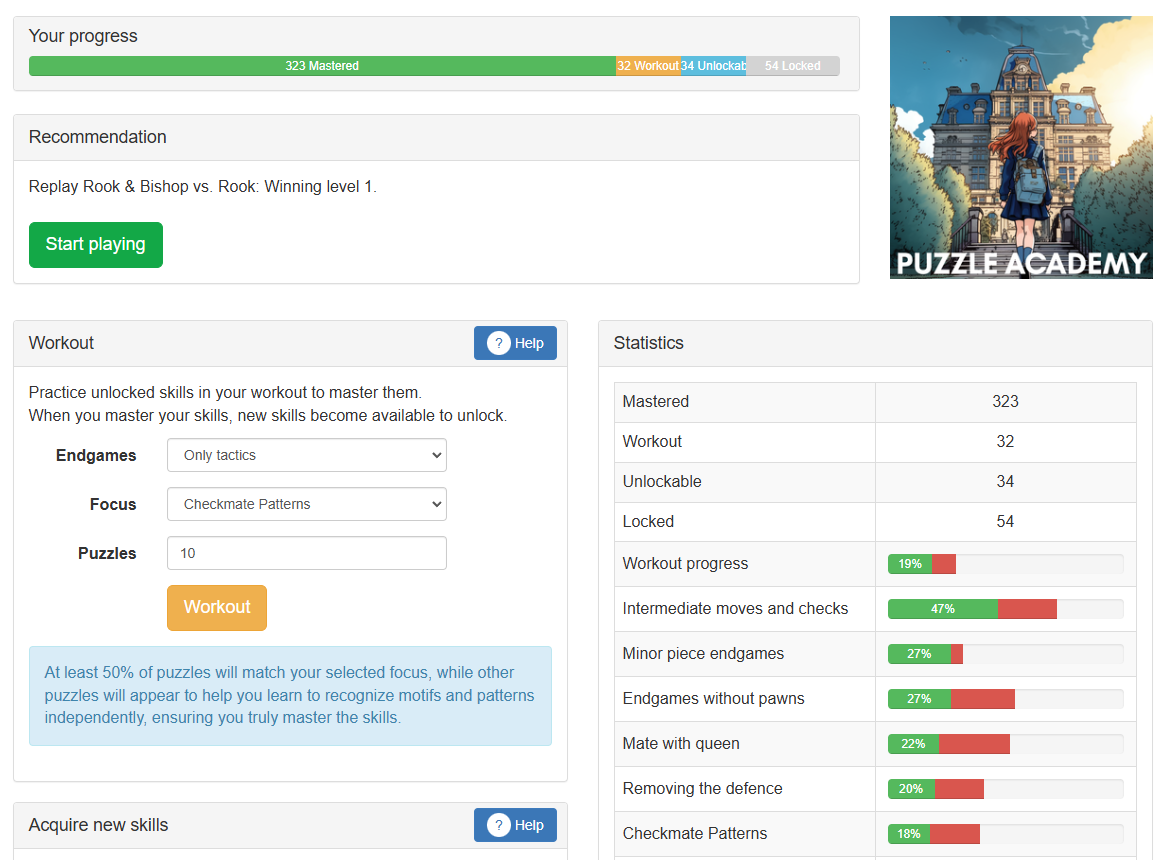
The Puzzle Academy dashboard has been updated with improvements to layout and usability, and updated guides.
Puzzle Academy also includes new content: Three new skills, five new levels, and new and updated guides. Read on for more details about the new content, including example puzzles from each new level.
Tactics: Garbage Collection, Level 1
In the "Tactics" course, there is a new skill called "Garbage Collection", with the first level. Hardly anyone knows it by name, yet everyone has encountered it on the board – garbage collection tactics. Garbage Collection is a situation where both sides threaten to win material with captures. These situations can be very confusing because they typically involve multiple options, each requiring precise calculation. Such scenarios arise quite regularly, often following a counterattack.
The new Garbage collection guide discusses the various ways how to react in this situation. Here is an example from level 1:
Black just played a discovered attack with e6-e5, and now both queens and the bishop on h3 are hanging. If White plays 1.Bxd7? exd4, White is going to lose a piece, because both of White's bishops are attacked. Therefore, White must defend with 1.Qh4, running away with the queen and protecting the bishop.
The solution view shows the threats for both sides, and includes some variations that you should avoid.
Combinations: Deflection from Skewer, Level 2
In the "Combinations" course, there is a new level two for the "Deflection from Skewer" skill. This is a combination where you deflect a piece away from defending a square where a skewer can be played. Level 2 includes puzzles with four moves. Here is a nice example:
Click the diagram to solve this puzzle.
Defence: Breaking the Pin, Level 1
In the "Defence" course, I've added a new skill "Breaking the Pin". A pin can become dangerous if the opponent threatens to attack the pinned piece, so it is good to know how to defend! The new Breaking the Pin guide discusses the various ways to defend when one of your pieces is pinned.
Here is an example from the first level:
Black has pinned the white knight with the battery on the d-file and is threatening Bf4 to attack it a third time. White can defend with 1.Be2 to overprotect the rook and break the pin.
The game continued 1...Bf4 2.Ne4 Rxd1 3.Bxd1, and White was slightly better off with the knight and two pawns for the rook.
Attacking: Weak Back-Rank, Level 3
In this skill, you can exploit the weak back-rank of your opponent by forcing checkmate or winning material. This is a situation which benefits a lot from the improvements made by version 3 of the puzzle algorithm. In this new level, the threat of back-rank mate leads to checkmate or a winning material advantage in four moves.
Here is a beautiful example:
Click the diagram to solve this puzzle.
Endgames: Queen against Rook, Level 1
In the "Endgames" course there is a new skill "Queen against Rook". In the first level you play the rook, and there are some tactics which allow you to draw or even win. Here is a typical example:
When the king is on the edge, and the queen is a knight-jump away and stalemates the king, desperado rook sacrifices become possible.
Here White can draw with perpetual check or stalemate: 1.Ra7+ Kb5 2.Rb7+ Ka6 (If the king goes to the c-file, White can win the queen with a pin, e.g. 2...Kc5 3.Rc7.) 3.Ra7+ Kb6 (If 3...Kb5, White can keep checking with 4.Rb7+) 4.Ra6+! Kxa6 stalemate (or 4...Kb5 5.Rxc6).
Experience the Latest Updates and Share Your Thoughts
Explore the latest updates and enhancements to ChessPuzzle.net and Puzzle Academy, designed to offer a better learning experience and new challenges for chess enthusiasts.
Visit Puzzle Academy to check out the new content today and start solving! Don't forget to check out the latest insights from Intermediate Chess Puzzles and share your feedback through the contact page.
Thank you for being a part of our community. Happy solving!

пятница, 13 декабря 2024 г.
Martin Bennedik
Founder of ChessPuzzle.net, International Correspondence Chess Master
Related posts
Updates to Puzzle Academy and Checkmate Armageddon
Following the recent major update of the website, we've added some new features to Puzzle Academy and improved the difficulty curve of Checkmate Armageddon.ChessPuzzle.net Version 3: The Website
I'm thrilled to announce that after several months of dedicated work, the all-new, modernized version of ChessPuzzle.net is now live for everyone! I've upgraded everything under the hood and refreshed the look and feel of your favorite chess puzzles platform.Beyond Classical Chess: ChessPuzzle.net Launches Chess 960 Puzzles
Challenge yourself with Chess 960 puzzles, where every game starts differently but tactical brilliance remains the same.
